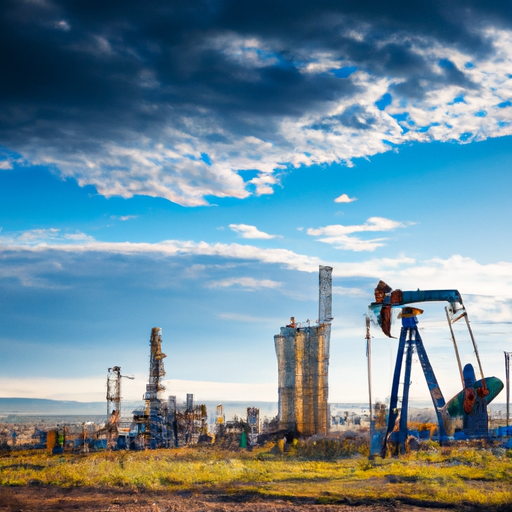Trends In Oil And Gas Industry
In this article, you will discover the latest trends shaping the oil and gas industry. As technology continues to advance at a rapid pace, the oil and gas sector is also undergoing significant transformations. From the rise of renewable energy sources to the increasing focus on sustainability, these trends are reshaping the way the industry operates. Additionally, with the global demand for energy constantly evolving, companies are adopting innovative approaches to enhance productivity and improve operational efficiency. Join us as we explore the key trends that are revolutionizing the oil and gas industry.

Table of Contents
1. Digital Transformation
1.1 Automation and Robotics
With the rapid advancements in technology, automation and robotics have become increasingly prevalent in the oil and gas industry. By utilizing automated systems and robots, companies can streamline their operations, improve efficiency, and reduce human error. For example, automated drilling rigs can perform complex drilling operations with high precision, minimizing the risk of accidents and increasing productivity. Additionally, robots can be employed for tasks such as maintenance and inspection, eliminating the need for human workers to be exposed to hazardous environments. The integration of automation and robotics not only enhances safety but also drives cost savings and improves overall operational performance.
1.2 Artificial Intelligence
Artificial intelligence (AI) has the potential to revolutionize the oil and gas industry by analyzing vast amounts of data and extracting valuable insights. Through machine learning algorithms, AI can identify patterns, predict equipment failures, optimize production processes, and enhance decision-making. For instance, AI-powered predictive maintenance systems can detect potential failures before they occur, allowing companies to perform necessary repairs and prevent costly downtime. Moreover, AI can be utilized in reservoir modeling and simulation, enabling more accurate predictions of oil and gas reservoir behavior. The integration of AI technologies can significantly improve operational efficiency and reduce costs for oil and gas companies.
1.3 Internet of Things
The Internet of Things (IoT) involves the interconnection of physical devices and sensors, enabling real-time data collection and analysis. In the oil and gas industry, IoT can be utilized to monitor and control various processes, enhance asset management, and improve safety. For instance, IoT sensors can be deployed to monitor equipment performance, detect leaks, or measure environmental parameters. This data can then be transmitted and analyzed in real-time, allowing companies to make informed decisions and take proactive measures. Additionally, IoT devices can enable remote monitoring and control, reducing the need for physical presence in the field. The widespread adoption of IoT technology in the oil and gas industry is transforming traditional practices and enabling companies to operate more efficiently and effectively.
2. Renewable Energy Transition
2.1 Shift towards cleaner sources
As the world focuses on reducing carbon emissions and combating climate change, the oil and gas industry is undergoing a significant transition towards cleaner sources of energy. There is a growing emphasis on investing in renewable energy technologies such as solar, wind, and hydropower. Companies are diversifying their portfolios and incorporating renewables into their energy mix to reduce their carbon footprint and meet sustainability targets. This shift towards cleaner sources is not only driven by environmental concerns but also by market forces and the increasing competitiveness of renewable energy.
2.2 Investments in renewable technology
To facilitate the renewable energy transition, oil and gas companies are making substantial investments in renewable technologies. They are leveraging their expertise, resources, and global presence to develop and deploy renewable energy projects. For instance, many oil and gas companies are investing in large-scale solar and wind farms, as well as exploring opportunities in emerging technologies such as geothermal energy and tidal power. These investments not only contribute to diversifying the energy mix but also provide new sources of revenue and growth for oil and gas companies.
2.3 Emerging role of green hydrogen
In addition to traditional renewable energy sources, green hydrogen is emerging as a promising option for the decarbonization of the oil and gas industry. Green hydrogen is produced by electrolyzing water using renewable electricity, resulting in a zero-carbon fuel. It can be utilized in various applications, such as power generation, transportation, and industrial processes. The oil and gas industry, with its existing infrastructure and expertise in hydrogen production and distribution, is well-positioned to play a key role in the development of the green hydrogen economy. By investing in green hydrogen technologies, companies can further reduce their carbon emissions and contribute to a more sustainable energy future.

3. Energy Efficiency
3.1 Adoption of energy-efficient technologies
Improving energy efficiency is a critical focus for the oil and gas industry, as it allows companies to reduce their energy consumption, lower operating costs, and minimize their environmental impact. Companies are increasingly adopting energy-efficient technologies and practices throughout their operations. For example, the use of advanced drilling techniques, such as horizontal drilling and multi-stage fracking, allows for the extraction of oil and gas with greater efficiency and reduced environmental footprint. Additionally, the implementation of energy-efficient equipment, such as compressors and pumps, helps to optimize energy usage and improve overall operational efficiency.
3.2 Sustainability initiatives
Oil and gas companies are actively implementing sustainability initiatives to address environmental concerns and meet stakeholders’ expectations. These initiatives encompass various aspects, including reducing greenhouse gas emissions, managing water resources, and minimizing waste generation. For instance, companies are adopting carbon capture and storage (CCS) technologies to capture and store carbon dioxide emissions, thereby mitigating their impact on climate change. Furthermore, water management strategies, such as water recycling and reduced freshwater consumption, are being implemented to minimize the industry’s impact on water resources.
3.3 Optimized production processes
Optimizing production processes is essential for improving energy efficiency and reducing operational costs in the oil and gas industry. Companies are employing advanced analytics and optimization techniques to enhance production efficiency and make data-driven decisions. By analyzing production data and real-time operational parameters, companies can identify areas for improvement, optimize production rates, and reduce energy waste. Additionally, the integration of digital technologies, such as smart sensors and control systems, enables more precise monitoring and control of production processes, further enhancing efficiency.
4. Decentralization and Distributed Energy
4.1 Microgrids and local energy systems
The concept of decentralization in the oil and gas industry involves shifting away from a centralized energy system towards localized energy generation and distribution. Microgrids, which are small-scale power grids that can operate independently or in conjunction with the main grid, are emerging as a viable solution for decentralized energy generation. Oil and gas companies are exploring the use of microgrids to power their operations, particularly in remote areas where access to the main grid may be limited or unreliable. By utilizing renewable energy sources, such as solar and wind, in microgrid systems, companies can reduce their reliance on fossil fuels and enhance energy resilience.
4.2 Localized energy generation
In line with the decentralization trend, oil and gas companies are increasingly investing in localized energy generation projects. This involves the development of renewable energy facilities, such as solar farms or wind turbines, in close proximity to their operations. By generating clean energy on-site, companies can reduce transmission losses and improve energy efficiency. Moreover, localized energy generation allows companies to have greater control over their energy supply, ensuring a reliable and sustainable source of power for their operations.
4.3 Energy storage solutions
As the integration of renewable energy sources increases, the need for effective energy storage solutions becomes crucial. Energy storage technologies, such as batteries and hydrogen storage, enable the capture and storage of excess energy for later use. Oil and gas companies are exploring the use of energy storage systems to balance the intermittency of renewable energy sources and enhance energy reliability. These storage solutions can be integrated into microgrid systems, allowing for a more sustainable and resilient energy supply.

5. Environmental Regulations and Sustainability
5.1 Stricter emissions standards
Environmental regulations play a significant role in shaping the operations of the oil and gas industry. Governments and regulatory bodies around the world are imposing stricter emissions standards to reduce the industry’s carbon footprint and mitigate the effects of climate change. Companies are required to comply with these regulations and implement measures to reduce their emissions. This includes adopting cleaner technologies, implementing emissions control systems, and monitoring and reporting their emissions accurately. Stricter emissions standards drive the industry towards greater environmental responsibility and the adoption of sustainable practices.
5.2 Carbon pricing mechanisms
Carbon pricing mechanisms, such as carbon taxes or emissions trading systems, are gaining momentum as policy tools to incentivize carbon reduction in the oil and gas industry. These mechanisms put a price on carbon emissions, forcing companies to internalize the environmental costs associated with their operations. By pricing carbon, companies are motivated to reduce their emissions and invest in cleaner technologies and practices. Carbon pricing mechanisms not only provide an economic incentive for emission reduction but also contribute to funding renewable energy projects and stimulating the transition to a low-carbon economy.
5.3 Integration of green practices
In response to environmental concerns and stakeholder expectations, oil and gas companies are integrating green practices throughout their operations. This includes adopting sustainable sourcing practices, minimizing waste generation, and pursuing eco-friendly alternatives. For example, companies are exploring the use of biofuels as an alternative to traditional fossil fuels, reducing the carbon intensity of their operations. Additionally, companies are engaging in reforestation and biodiversity conservation initiatives to mitigate the environmental impact of their activities. The integration of green practices demonstrates the industry’s commitment to environmental sustainability and responsible resource management.
6. Geopolitical Dynamics
6.1 Shifting global energy demand
Global energy demand is undergoing significant shifts, driven by various geopolitical factors. Economic growth, demographic changes, and policy developments influence the demand for oil and gas across different regions. For instance, the growing middle-class population in emerging economies is expected to drive an increase in energy consumption. However, there is also a global push to reduce reliance on fossil fuels, diversify energy sources, and transition towards cleaner alternatives. Understanding these shifting dynamics is essential for oil and gas companies to adapt their strategies and remain competitive in an evolving energy landscape.
6.2 Political instability and conflict
Political instability and conflict in oil-producing regions can have significant ramifications for the oil and gas industry. Disruptions in the supply chain, geopolitical tensions, and sanctions can impact global oil prices and supply security. Companies need to assess these risks and develop contingency plans to mitigate the impact of political instability on their operations. Additionally, fostering stable geopolitical relationships and diplomatic engagements is crucial for the industry’s long-term sustainability and uninterrupted energy supply.
6.3 Energy trade agreements
Energy trade agreements play a vital role in shaping the global oil and gas market. These agreements govern the export and import of energy resources and establish frameworks for cooperation between nations. Trade agreements can offer stability, facilitate market access, and create opportunities for oil and gas companies to expand their operations globally. Collaborative initiatives, such as transnational pipelines, joint ventures, or supply contracts, strengthen energy partnerships between countries and contribute to the overall stability of the industry.

7. Data Analytics and Big Data
7.1 Predictive analytics in exploration
Data analytics and big data technologies are revolutionizing the exploration phase of the oil and gas industry. By analyzing vast amounts of geological and seismic data, companies can identify potential hydrocarbon reservoirs with greater accuracy and efficiency. Predictive analytics techniques allow for the identification of patterns and anomalies in the data, enabling more informed decision-making and reducing exploration risks. By leveraging data analytics, companies can optimize their exploration activities, reduce costs, and improve the success rate of drilling operations.
7.2 Operational performance optimization
Data analytics and big data play a crucial role in optimizing operational performance in the oil and gas industry. By analyzing real-time operational data, companies can identify areas of improvement, enhance efficiency, and reduce costs. For example, predictive maintenance systems powered by data analytics can detect equipment failures before they occur, enabling proactive maintenance and minimizing downtime. Furthermore, data analytics can optimize production processes, such as well drilling, by identifying the most efficient drilling parameters and reducing waste. The integration of data analytics and big data technologies enhances operational performance and enables companies to make data-driven decisions.
7.3 Improved decision-making
Data analytics and big data provide oil and gas companies with valuable insights and support decision-making processes at various levels. By integrating data from different sources, companies can gain a holistic view of their operations and identify opportunities for improvement. Data-driven decision-making enables companies to optimize resource allocation, manage risks, and achieve operational excellence. Additionally, analytics tools can provide real-time monitoring and reporting capabilities, giving decision-makers timely information to respond swiftly to changing market conditions or operational challenges.
8. Reshaping Workforce
8.1 Skill requirements and upskilling
The digital transformation and changing dynamics in the oil and gas industry require a shift in the skill sets and capabilities of the workforce. As automation, robotics, and digital technologies become more prevalent, there is a growing demand for workers with expertise in these areas. Companies are investing in upskilling and reskilling programs to equip their workforce with the necessary digital skills and knowledge. Additionally, collaboration with academic institutions and the development of partnerships can help bridge the skills gap and ensure a future-ready workforce.
8.2 Remote work and digital collaboration
The COVID-19 pandemic has accelerated the adoption of remote work and digital collaboration in the oil and gas industry. Companies are leveraging technology to facilitate virtual meetings, remote monitoring, and digital project management. This shift towards remote work not only enables business continuity during crises but also offers flexibility and cost savings. Furthermore, digital collaboration tools enhance communication and collaboration among geographically dispersed teams, fostering innovation and knowledge sharing.
8.3 Enhancing diversity and inclusion
Promoting diversity and inclusion in the oil and gas industry is key to fostering innovation, driving performance, and ensuring a sustainable future. Companies are recognizing the value of diverse perspectives and experiences, both in terms of gender and cultural diversity. Efforts are being made to attract, retain, and advance a diverse workforce through inclusive policies and practices. By embracing diversity and inclusion, companies can tap into a broader talent pool, improve decision-making, and enhance organizational performance.
9. Circular Economy Initiatives
9.1 Waste reduction and recycling
The adoption of circular economy principles is gaining momentum in the oil and gas industry to address waste generation and resource consumption. Companies are implementing waste reduction and recycling initiatives to minimize the environmental impact of their operations. For example, practices such as drilling waste management, water recycling, and reusing materials can significantly reduce waste generation and conserve resources. Furthermore, companies are exploring innovative solutions, such as converting waste into valuable byproducts or utilizing waste heat for other industrial processes, to maximize the value extracted from resources.
9.2 Resource efficiency programs
Resource efficiency programs are an essential component of circular economy initiatives in the oil and gas industry. These programs focus on optimizing resource consumption, minimizing energy waste, and improving the overall efficiency of operations. Companies are implementing strategies such as energy efficiency audits, leak detection programs, and process optimization to reduce resource intensity. By adopting resource efficiency measures, companies can enhance their environmental performance, reduce costs, and contribute to the transition to a more sustainable energy system.
9.3 Closing material loops
Closing the material loops refers to the practice of reducing waste by recycling and reusing materials within the oil and gas industry. Companies are actively exploring opportunities to convert waste materials into valuable resources and eliminate the need for virgin inputs. For example, plastic waste generated during operations can be recycled and transformed into useful products or used as feedstock in other industries. By closing material loops, companies can minimize their environmental impact, enhance resource stewardship, and contribute to a circular economy.
10. Shift towards Natural Gas
10.1 Transition from coal to natural gas
The transition from coal to natural gas is a significant trend in the oil and gas industry driven by environmental concerns and the need for cleaner energy sources. Natural gas is considered a relatively cleaner fossil fuel compared to coal, emitting lower levels of greenhouse gases and air pollutants. As governments and companies seek to reduce carbon emissions, many are shifting their energy generation from coal-fired power plants to natural gas power plants. This transition helps to decrease the environmental impact of power generation while maintaining a reliable and cost-effective energy supply.
10.2 Growing demand for liquefied natural gas
The demand for liquefied natural gas (LNG) is experiencing significant growth due to its versatility, transportability, and environmental benefits. LNG can be easily transported over long distances, facilitating access to global markets. Its cleaner burning characteristics make it an attractive alternative to traditional fossil fuels in various sectors, including power generation, transportation, and industrial processes. The increasing demand for LNG presents opportunities for oil and gas companies to invest in LNG infrastructure, liquefaction plants, and regasification terminals to meet the growing global demand.
10.3 Expanding infrastructure for gas transportation
To support the shift towards natural gas, the oil and gas industry is expanding the infrastructure for gas transportation. This includes the construction of pipelines, storage facilities, and LNG terminals to facilitate the movement of natural gas from production sites to end-users. Companies are investing in the development of cross-border pipelines and interconnectors to enhance energy security and diversify gas supply sources. The expansion of gas transportation infrastructure enables the efficient distribution of natural gas and contributes to the growth of the natural gas market.






